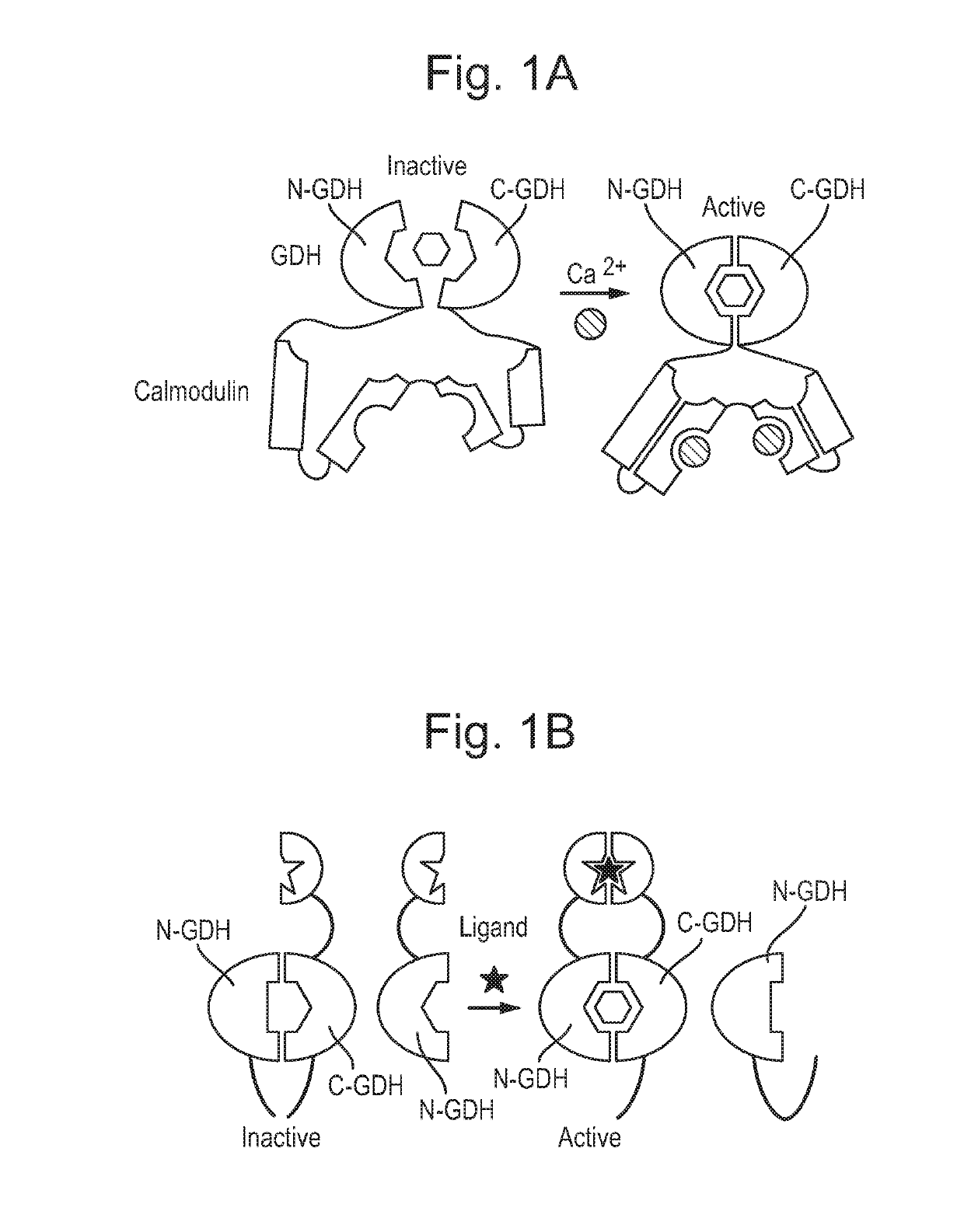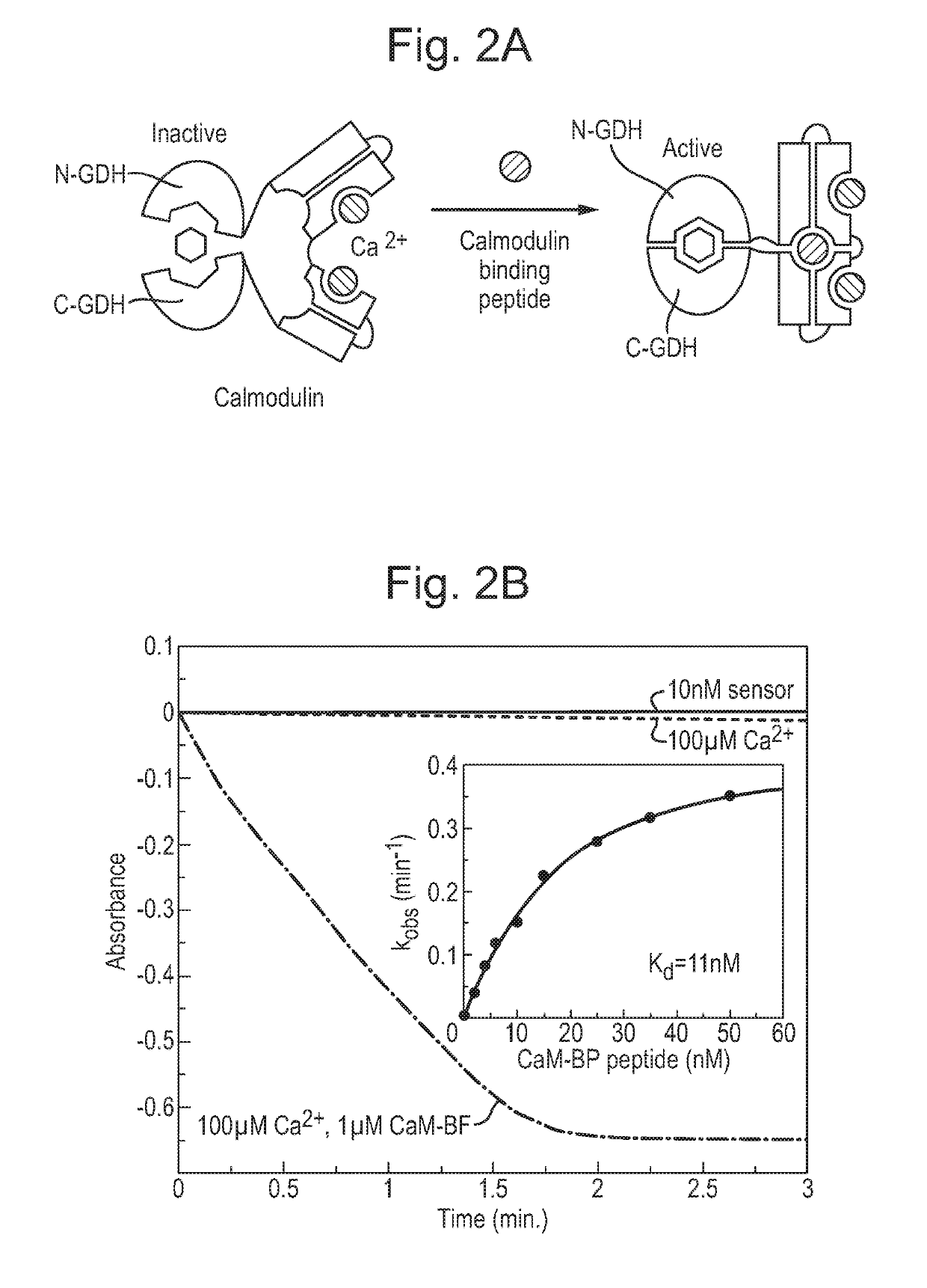Ultrasensitive electrochemical biosensors
a biosensor and ultra-sensitive technology, applied in the field of biosensors, can solve the problems that the technological and commercial success of other electrochemical biosensors has not been paralleled, and achieve the effects of high specificity, easy production, and easy detection of the presence or activity of target molecules
- Summary
- Abstract
- Description
- Claims
- Application Information
AI Technical Summary
Benefits of technology
Problems solved by technology
Method used
Image
Examples
example 1
for Construction of Insertion Peptide-Responsive Mutant of PQQ-GDH
[0173]We previously identified the loop connecting strands A and B of beta-sheet 3 of PQQ-GDH as a site able to tolerate insertion of a calmodulin protein. The resulting calmodulin-GDH chimera (FIG. 1A) demonstrated calcium-binding activity and acted solely as a calcium sensor. The same location was also amenable to splitting GDH into two inactive fragments that could then be reconstituted into an active enzyme via scaffolding interactions with an analyte (FIG. 1B, SEQ ID NOs 43 and 44). The splitting approach allowed for coupling of GDH activity to detection of various analytes, but required proteolytic cleavage and purification of components, and also had a response rate governed by the rate of reconstitution of components. Analyte-drived dimerisation was also required for activity.
[0174]We sought an approach that would allow conversion of GDH into a allosteric peptide regulated ON or OFF switch that can be subseque...
example 2 -
Example 2-Construction of Two Component Biosensors Based on the Peptide-Activated GDH Chimera
[0176]We next decided to test if the developed allosteric module can be used to construct a generic biosensor architecture. To this end we fused the developed CaM-GDH chimera C-terminally with rapamycin-binding FKBP domain (SEQ ID NO: 11) and produced the protein in recombinant form. As expected the protein displayed minimal GDH activity in the absence of the CaM-BP. We then constructed a fusion between FKBP binding partner FRB and CaM-BP that would associate with the former reporter molecule in the rapamycin dependent fashion. We reasoned that such a unit should operate cooperatively and its overall affinity in the absence of the ligand should be at least an order of magnitude lower than in its presence.
[0177]Therefore we analyzed the structure of CaM:CaM-BP complex (PDB;2BBM) to design a mutation of CaM-BP that would on one hand significantly reduce the affinity of the CaM-BP. We concluded...
example 3
ion of a Ligand-Activated Sterically Auto-Inhibited Cam-GDH Module
[0181]Next we attempted to aggregate the developed biosensor architecture into a single sensory unit. We conjectured that if the activating peptide could be kept away from the Cam-GDH in the ligand controlled fashion it would allow both parts of the biosensor to reside in the same molecule. To this end we constructed a fusion protein consisting of Cam-GDH chimera flanked by the PDZ domain and a fusion of CaM-BP fused to PDZ domain binding peptide via thrombin cleavage site (FIG. 4A, SEQ ID NO: 29). The resulting fusion protein displayed reduced GDH activity that could be induced by the exposure to the PDZ peptide or thrombin protease (FIG. 4B).
[0182]Further improvements of the biosensors could include additional binding sites for steric inhibitor that would shift the equilibrium towards the sterically auto inhibited state (FIG. 4C). While the presented example is based on detection of PDZ peptide any other binder liga...
PUM
| Property | Measurement | Unit |
|---|---|---|
| pH | aaaaa | aaaaa |
| catalytic activity | aaaaa | aaaaa |
| affinity | aaaaa | aaaaa |
Abstract
Description
Claims
Application Information
 Login to View More
Login to View More - R&D
- Intellectual Property
- Life Sciences
- Materials
- Tech Scout
- Unparalleled Data Quality
- Higher Quality Content
- 60% Fewer Hallucinations
Browse by: Latest US Patents, China's latest patents, Technical Efficacy Thesaurus, Application Domain, Technology Topic, Popular Technical Reports.
© 2025 PatSnap. All rights reserved.Legal|Privacy policy|Modern Slavery Act Transparency Statement|Sitemap|About US| Contact US: help@patsnap.com



